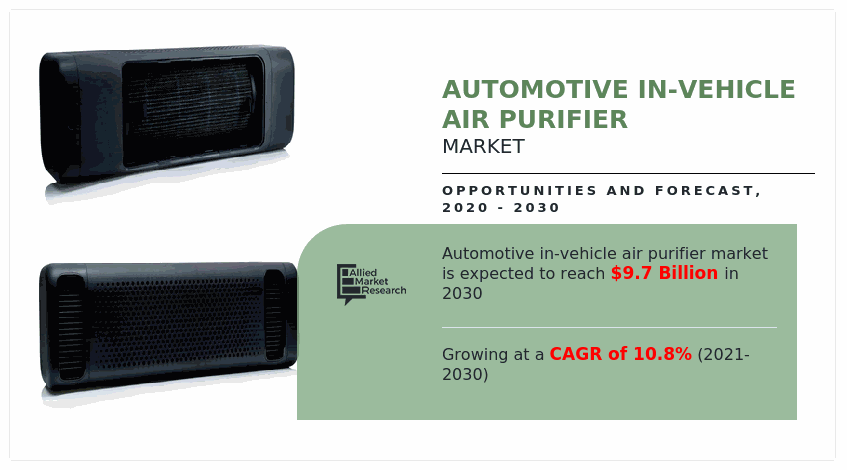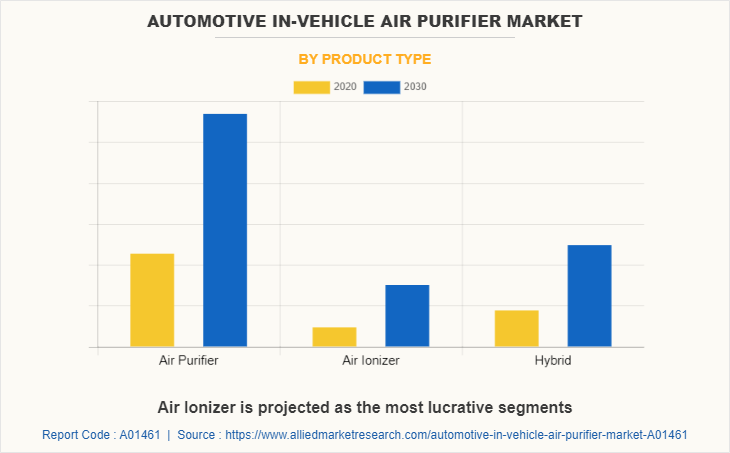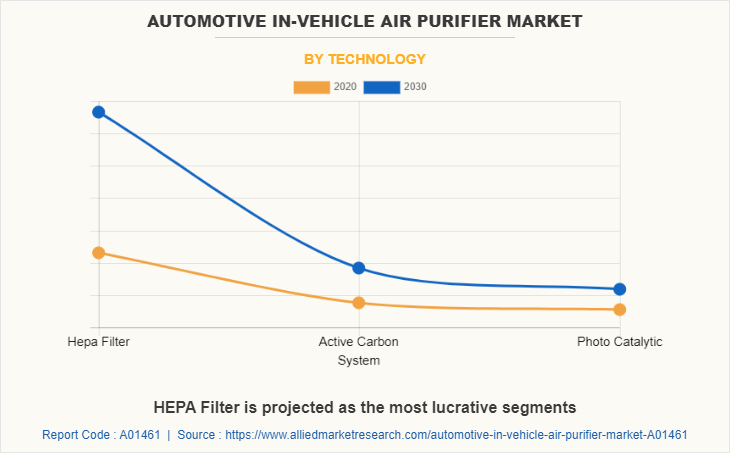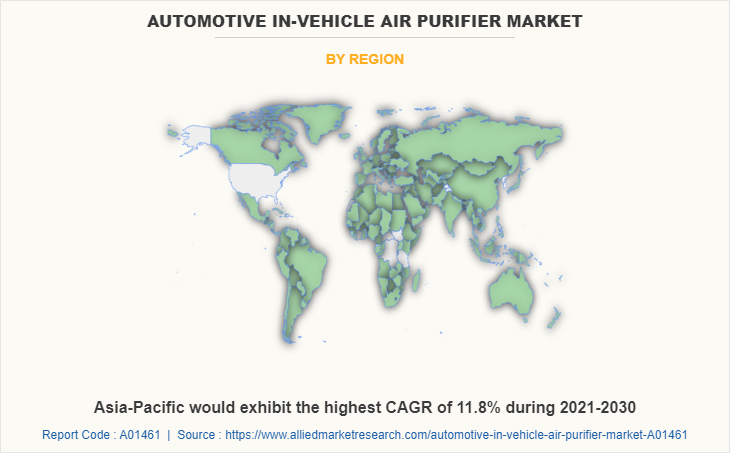The global automotive in-vehicle air purifier market was valued at $3.6 billion in 2020, and is projected to reach $9.7 billion by 2030, growing at a CAGR of 10.8% from 2021 to 2030.
An automotive in-vehicle air purifier is a piece of equipment that removes contaminants from the air within the car and rejuvenates mood of people by removing odors.. It works by removing the odor, dust, mold, bacteria, pet dander, and harmful microorganism and helps people suffering from asthma and allergies to breathe fresh air every time they enter the car. HEPA filters and ionizers are the fundamental technologies utilized in in-vehicle air purifiers. The device has automated power adjustment based on air quality and separate LED indicators for each power mode. Presently, the adoption of automotive in-vehicle air purifiers expanded from passenger cars to light & heavy commercial vehicles. Cab owners, school buses, private & public transport vehicles including bus & vans, and truck operators vigilantly install these purifiers to provide better service to their customers and take precautionary measures to safeguard health of the passengers and vehicle drivers.

Furthermore, the adoption of in-vehicle air purifiers in automobiles is comparatively higher in the Asia-Pacific. This is attributed to the fact that developing countries in Asia-Pacific are primarily affected by air pollution, and automobile manufacturers and the governments are taking initiatives to promote technologies that will help reduce harmful effects of toxic air. For instance, in 2020, the Chinese Ministry of Environmental Protection, announced regulatory standards for all provinces, municipalities, and autonomous regions to reduce air pollution. These standards aim to reduce factory and power plant emissions of four significant pollutants, including arsenic, asbestos, benzene, and dioxin and mitigate airborne sulfur dioxide emissions by 12.9%.

Factors including increase in demand for clean and toxin-free cabin air and increase in pollution level of atmospheric air are expected to drive the growth of the automotive in-vehicle air purifier market. In addition, need for toxic-free healthy automobile atmosphere and increase in awareness about the health issues among end users boost the market growth. However, less manufacturers of in-vehicle air purifiers, high cost, and non-standardization of air purification system restrain the market growth. Furthermore, the development of advanced& low-cost air purifier systems and expansion in untapped markets of Asia-Pacific & LAMEA are expected to provide lucrative growth opportunities for the market players.
The automotive in-vehicle air purifier market is segmented on the basis of product type, technology, vehicle type, sales channel, and region. Depending on product type, it is classified into air purifiers, air ionizers, and hybrid. According to technology, it is categorized into high-efficiency particulate arrestor (HEPA), active carbon systems, and photo catalytic purifier. As per vehicle type, it is fragmented into passenger cars, light commercial vehicles, and heavy commercial vehicles. By sales channel, it is segmented into original equipment manufacturers (OEMs) and aftermarket. Region wise, it is analyzed across North America, Europe, Asia-Pacific, and LAMEA.

The key players operating in the global automotive in-vehicle air purifier market are DENSO Corporation, Eureka Forbes, Guangzhou Ionkini Technology Co., Ltd., Honeywell International Inc., KENT RO Systems Ltd., Koninklijke Philips N.V., Livpure Smart, Power4 Industries Limited, Purafil, Inc., and Sharp Corporation.
Increase in Demand for Clean and Toxin-free Cabin Air
Urbanization increased the number of vehicles and traffic congestion, which led to increased air pollution. According to the center of science and environment in India, air pollution is responsible for 12.5% of overall deaths in India and kills an average of 8.5 out of every 10,000 children in India before they turn five. Thus, the increase in pollution levels propelled the public to adopt measures to curb these pollution levels. Automotive in-vehicle air purifiers technologies, including HEPA and active carbon system air improve the quality of air inside vehicles by removing allergens and odors. For instance, in 2020, Philips launched the GoPure range of car air purifiers with powerful 3-stage filtration technology capable of removing up to 125 harmful pollutants and exhaust gases through its HEPA and HESA layers. Thus, people gradually shift toward the adoption of these technologies as a result of R&D for innovative, new, and advanced products by companies.
Increase in the Pollution Level of Atmospheric Air
Industrialization and urbanization cause significant increase in pollutants levels in atmosphere. Moreover, rise in number of vehicles on road is a primary reason for increasing pollution levels. Such activities add toxic pollutants like sulfur oxides, nitrogen oxides, carbon monoxide, and volatile organic compounds (VOCs) to the environment. This resulted in degradation of air quality index, causing health ailments in many countries. As per data released by the World Health Organization (WHO), in 2021, more than 80% of the people living in urban areas are exposed to air quality levels that exceed the WHO limits. People in low-income cities are most affected. For instance, governments across the globe are taking measures to reduce pollution levels. The U.S. government implemented a partnership act with Environmental Protection Agency (EPA) to reduce pollution & contribute to air quality problems in a downwind state. Hence, to control the increasing pollution levels of atmospheric air, the sales of automotive in-vehicle air purifiers will grow substantially during the forecast period.
Small Number of Global Manufacturers of in-vehicle Air Purifier
Major manufacturers such as Kent RO Systems Ltd., Eureka Forbes, Honeywell, and Philips have offices and manufacturing facilities across the globe. Furthermore, other companies are local to particular regions. Thus, the absence of manufacturing facilities results in low production of air purifiers across the globe. However, companies try to expand their manufacturing facilities across the globe. In addition, governments develop new modes such as public-private partnerships with private entities to intensify the efforts. Such public-private partnerships would help improve the situation with an active effort from private sector players. Hence, small number of global manufacturers of in-vehicle air purifiers across the globe is a significant restraint associated with the growth of the automotive in-vehicle air purifier market.

Development of Advanced and Low-cost Air Purifier System
Gradual rise in the income of people & increase in health-related concerns leads the automotive in-vehicle air purifier manufacturers to focus on the R&D for innovation & production of advanced automotive air purifiers that will have high-efficiency rate and low cost. For instance, in 2019, Sharp Corporation launched the new ‘FP-JC2M-B’ car air purifier, especially designed and built for India, by using dual technology of HEPA & carbon filters, which remove PM2.5 and other gaseous substances to generate fresh air & eliminates toxic fumes, gases, and reduces static electricity for clean and odorless air. Furthermore, adoption of multifunctional in-vehicle air purifiers that incorporate features such as Bluetooth speaker, USBs, lights, air conditioner to cool, fan to circulate air, and the dehumidifier to remove moisture has evolved the trend among the key players. In addition, companies try to downsize air purifiers in vehicles. Properties of small air purifiers, including small size and low cost add another dimension to their usefulness. Thus, the development of advanced automotive in-vehicle air purifiers is expected to unfold various opportunities for leading players in future.
Key Benefits For Stakeholders
- This study presents the analytical depiction of the global automotive in-vehicle air purifier market analysis along with the current trends and future estimations to depict imminent investment pockets.
- The overall market opportunity is determined by understanding profitable trends to gain a stronger foothold.
- The report presents detailed impact analysis information related to the key drivers, restraints, and market opportunities.
- The current market is quantitatively analyzed from 2021 to 2030 to benchmark financial competency.
- Porter’s five forces analysis illustrates the potency of the buyers and suppliers in the automotive in-vehicle air purifier industry.
Automotive In-Vehicle Air Purifier Market Report Highlights
| Aspects | Details |
| By Product Type |
|
| By Technology |
|
| By Vehicle Type |
|
| By Sales Channel |
|
| By Region |
|
| Key Market Players | Guangzhou Ionkini Technology Co., Ltd., Power4 Industries Limited, eureka forbes ltd, Koninklijke Philips N.V., DENSO CORPORATION, KENT RO Systems Ltd, Honeywell International Inc., Sharp Corporation, purafil, inc., Livpure Smart |
| Other players in the value chain include | Nostrum Energy, TI Automotive, GP Performance, Infineon Technologies AG, Synerject LLC, Renesas Electronics Corporation, Airtex Products |
Analyst Review
Presently, automotive in-vehicle air purifier market witnessed an upsurge, owing to adoption of personal vehicles, including sedans and special utility vehicles (SUVs) and investment in automotive in-vehicle air purifier technology. In accordance with the insights of the CXOs of leading companies, the global automotive in-vehicle air purifier market is expected to grow at a remarkable rate in future in the developing countries such as India and China. Moreover, mandatory government laws and regulations for automobile manufacturers to incorporate air purifiers in their vehicles are expected to create numerous opportunities for the key players operating in the automotive in-vehicle air purifier market. In 2019, Sharp Corporation launched the new ‘FP-JC2M-B’ car air purifier, especially designed and built for India, by using dual technology of HEPA & carbon filters which remove PM2.5 and other gaseous substances to generate fresh air & eliminates toxic fumes, gases, and reduces static electricity for clean and odorless air.
According to insights gathered from primary sources, the automotive companies focus on producing advanced automotive in-vehicle air purifiers that have features of both air purifiers and air ionizers along with economical cost. For instance, in 2018, Honeywell International Inc. launched Move Pure 2, a car air purifier in India with an advanced double-layer active carbon filter and high-grade HEPA technology that removes total volatile organic compounds (TVOC), cigarette smoke, and bacteria. This product is designed specifically for the Indian market, and its filtration technology claims to remove up to 99% of in-car air pollution. Moreover, companies try to expand their manufacturing facilities in the untapped markets of Asia-Pacific and LAMEA. As in various countries, including India, South Africa, and the Middle East, the market is in an emerging phase and indicates dynamic growth during the forecast period
Region wise, Asia-Pacific is the highest revenue contributor, followed by Europe, North America, and LAMEA. Asia-Pacific is expected to maintain its lead during the forecast period, owing to the increase in sales of luxury vehicles across countries in Asian region
TThe global automotive in-vehicle air purifier market was valued at $3.6 billion in 2020, and is projected to reach $9.7 billion by 2030, growing at a CAGR of 10.8% from 2021 to 2030.
Numerous companies have been operating in the market and holds majority of market share in the global automotive in-vehicle air purifier market.
The report sample for global automotive in-vehicle air purifier market report can be obtained on demand from the website.
The key segments covered in the report includes product type, technology, vehicle type, sales channel and region.
Air Purifier, Air Ionizer and Hybrid air purifiers are the different types of air purifiers used in automotive industry.
The company profiles of the top players of the market can be obtained from the company profile section mentioned in the report. This section includes analysis of top player’s operating in the industry along with their last three-year revenue, segmental revenue, product offerings, key strategies adopted, and geographical revenue generated.
Loading Table Of Content...



